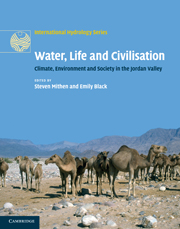Book contents
- Frontmatter
- Contents
- List of figures
- List of tables
- List of contributors
- Acknowledgements
- 1 Introduction: an interdisciplinary approach to Water, Life and Civilisation
- Part I Past, present and future climate
- Part II The palaeoenvironmental record
- Part III Hydrological studies of the Jordan Valley
- 10 The impacts of climate change on rainfall-runoff in the upper River Jordan: methodology and first projections
- 11 Modelling Dead Sea levels and rainfall: past, present and future
- 12 The hydrology of the Wadi Faynan
- 13 Future projections of water availability in a semi-arid region of the eastern Mediterranean: a case study of Wadi Hasa, Jordan
- Part IV Human settlement, climate change, hydrology and water management
- Part V Palaeoeconomies and developing archaeological methodologies
- Part VI Society, economy and water today
- Part VII Conclusions
- Index
- Plate section
- References
12 - The hydrology of the Wadi Faynan
from Part III - Hydrological studies of the Jordan Valley
Published online by Cambridge University Press: 26 April 2011
- Frontmatter
- Contents
- List of figures
- List of tables
- List of contributors
- Acknowledgements
- 1 Introduction: an interdisciplinary approach to Water, Life and Civilisation
- Part I Past, present and future climate
- Part II The palaeoenvironmental record
- Part III Hydrological studies of the Jordan Valley
- 10 The impacts of climate change on rainfall-runoff in the upper River Jordan: methodology and first projections
- 11 Modelling Dead Sea levels and rainfall: past, present and future
- 12 The hydrology of the Wadi Faynan
- 13 Future projections of water availability in a semi-arid region of the eastern Mediterranean: a case study of Wadi Hasa, Jordan
- Part IV Human settlement, climate change, hydrology and water management
- Part V Palaeoeconomies and developing archaeological methodologies
- Part VI Society, economy and water today
- Part VII Conclusions
- Index
- Plate section
- References
Summary
ABSTRACT
This chapter describes the hydrology of the Wadi Faynan and the potential changes to the hydrology that may occur under rainfall and vegetation change scenarios. The Wadi Faynan is a meso-scale (241 km2), semi-arid catchment in southern Jordan, considered internationally important because of its rich archaeological heritage spanning the Pleistocene and Holocene. This is the first study to describe the hydrological functioning of the catchment, setting it within the framework of contemporary archaeological investigations. Historic climate records were collated and supplemented with new hydrological and water quality data. These data were analysed in relation to catchment geology and used to build a conceptual hydrological model. The analysis established the importance of the geology in determining the hydrological functioning of the catchment and suggested probable reasons for the initial settlement of the catchment. The potential impacts of rainfall and vegetation change were simulated using an application of the Pitman model. Results suggest that increased rainfall in the catchment where there is sparse vegetation can lead to increased flood magnitude and frequency. Increased rainfall alone does not necessarily imply better conditions for farming. The simulations also demonstrate that increased vegetation enhances infiltration, and a dense vegetation cover, when coupled with higher rainfall, leads to a more secure water resource characterised by a higher base flow and reduced flood frequency.
- Type
- Chapter
- Information
- Water, Life and CivilisationClimate, Environment and Society in the Jordan Valley, pp. 157 - 174Publisher: Cambridge University PressPrint publication year: 2011
References
- 1
- Cited by



